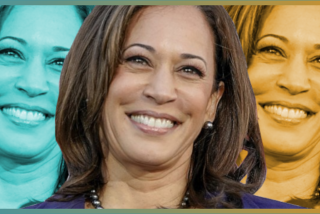Gore Keeps One Foot in Washington
- Share via
CARBONDALE, Pa. — As he campaigned nonstop in four hotly contested states during a 28-hour stretch over Labor Day, no one could doubt Al Gore’s tireless devotion to his White House quest.
Yet with fanfare or public notice, the vice president is still playing a key role in the final months of the Clinton administration, making his presence felt on matters large and small.
“The vice president may be out there on the campaign trail,” said Charles Burson, Gore’s White House chief of staff, “but he’s very much engaged on the issues of governance.”
Of late, Gore has met with visiting foreign leaders, such as his Aug. 24 session with Mexican President-elect Vicente Fox. He recently signed, on behalf of the government, a plutonium disposition agreement with Russia. Next week, Gore is scheduled in Washington to meet with Indian Prime Minister Atal Behari Vajpayee.
Such tete-a-tetes have been low-key, but now, as the 2000 campaign heads into the homestretch, Gore’s behind-the-scenes role may soon come to an end.
With a high-stakes, end-of-session showdown looming between the White House and the Republican Congress over spending priorities and legislative pet projects, the vice president could well be thrust fully into the limelight.
Or so Gore can hope.
A high-profile fight with congressional Republicans--whether over a patients’ bill of rights or funding for education--presents Gore with a chance to portray himself as a populist fighter for working families.
For now, serving as vice president while campaigning all-out for the top job is a demanding balancing act for Gore--and for both his vice presidential staff in Washington and his campaign staff in Nashville.
Adding to the challenge is Gore’s utter devotion to his family. When his various schedulers meet, first to go down on Gore’s calendar are such personal items as his son’s football games or a daughter’s birthday. Then negotiations begin between Washington and Nashville.
Gore Thursday campaigned at Gentex, a firm that has successfully remade itself from the nation’s largest maker of silk fabric to a top manufacturer of safety equipment for the military, police and firefighters. The vice president talked up his newly released economics plan while pressing his attack on his opponent, Texas Gov. George W. Bush, for not releasing more details about his agenda--”details that the other side wants to overlook,” as Gore put it.
Gore charged that Bush’s proposal to partially privatize Social Security would “leave a gaping hole of $1 trillion over 10 years” and asked the Gentex workers: “Don’t you want to know the answer to where that trillion dollars are going to come from?”
To reinforce Gore’s strategy of “compare and contrast,” the Gore campaign on Thursday took out a full-page ad in the New York Times questioning Bush’s economic agenda.
Also Thursday, he finally won the endorsement of the 1.4-million-member Teamsters union, flew to New Orleans for a rally and addressed, via satellite, the National Baptist Convention in Los Angeles.
Even though Gore may be visiting several states in a single day, the routine of his vice presidential office does not vary a great deal, Burson said.
Gore regularly receives a national security briefing from his longtime aide, Leon Fuerth. Other senior aides on Gore’s vice presidential staff continue to meet each morning, including with their counterparts on President Clinton’s staff. Such sessions are designed to ensure that both men stay on the same message and that neither is taken by surprise.
Thus, for instance, when Clinton last month vetoed the GOP bill repealing the inheritance tax, Gore knew well ahead of time. And when Clinton announced that he was delaying a decision on national missile defense, Gore was able within minutes to issue a statement endorsing the move.
It was such precisely close coordination--between his staff and Senate Democrats--that last year allowed Gore, fulfilling his constitutional duty as president of the Senate, to cast one of his highest-profile votes there as vice president.
With the Senate deadlocked, 50 to 50, on a vote to impose background checks on prospective gun buyers at gun shows, Gore rushed to Capitol Hill and cast the deciding vote, giving him bragging rights as an ardent gun control advocate.
This year, Gore has gone to the Capitol four times in case his votes were needed. One time, when Air Force Two was not ready to make the unscheduled trip, Gore hastily boarded a commercial shuttle in New York. On those occasions, however, the simple prospect of Gore casting another tie-breaking vote on a major issue prompted enough Senate Republicans to switch their positions to deny Gore that opportunity.
In the coming weeks, Gore may well be making more such trips, with so many contested issues looming on the agenda between the White House and Congress. The bones of contention include the patients’ rights bill, prescription drug coverage for seniors, gun control and funding for education and community policing.
“We’re looking at a very active, pretty intense period coming up. There are lots of unresolved issues,” Burson said.
No fight looms larger than the patients’ bill of rights controversy in the Senate.
With the appointment of Sen. Zell Miller (D-Ga.) to succeed the late Paul Coverdell, a Republican, Senate Democrats believe they now have a 50th vote for the HMO reform measure--if no votes change.
Senate Republicans are unlikely to allow Gore and his running mate, Sen. Joseph I. Lieberman of Connecticut, to swoop into the Senate and cast the deciding votes to pass the measure. The mere possibility of such a dream Democratic scenario might persuade the GOP to pass such a bill over to the House.
More to Read
Get the L.A. Times Politics newsletter
Deeply reported insights into legislation, politics and policy from Sacramento, Washington and beyond. In your inbox twice per week.
You may occasionally receive promotional content from the Los Angeles Times.







